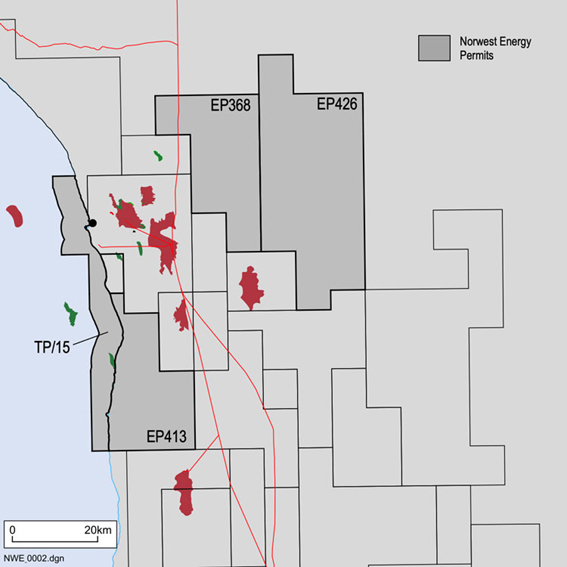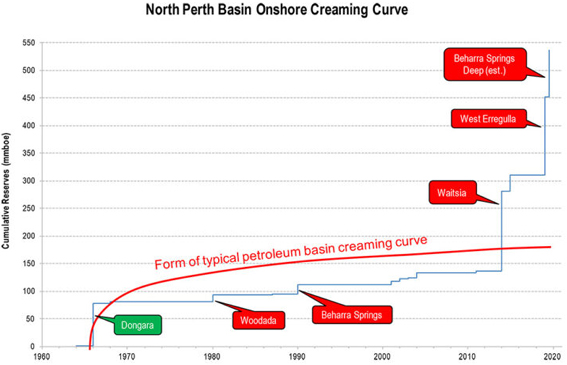- Preliminary drilling results indicate a significant conventional gas discovery at Lockyer Deep-1
- Gas encountered in excellent quality Kingia Sandstone, and additional gas potential within High Cliff Sandstone
- Apparent absence of gas water contact in Kingia supports the case for a large resource across the greater Lockyer Deep/North Erregulla Deep structure
- Potential conventional oil resource encountered within Dongara/Wagina sandstones
- Drilling reached Total Depth of 4,274 metres on 6 September 2021
- Wireline logging program underway, positive results from which will lead to the well being completed for production testing
Perth Basin oil and gas exploration company Norwest Energy provides the following update regarding operations and preliminary results at the Lockyer Deep-1 conventional gas exploration well. Further to the Company's announcement on 30 August 2021, the bottom hole was drilled from a depth of 3,097 metres, reaching Total Depth of 4,274 metres in the Holmwood Shale at 24:00 hrs. on 6 September 2021.
The top of the Kingia Sandstone was intersected at 4,041 metres with a pronounced drilling break accompanied by elevated gas levels from 4,041 metres to 4,067 metres. Maximum total gas of 89% was recorded. Logging While Drilling (LWD) resistivity separation indicates good inferred porosities throughout a gross reservoir interval of approx. 26 metres with an expected high net to gross ratio. Elevated gas readings continued throughout the Kingia section within sandstones to the top of the Bit Basher Shale at 4,109 metres. Based on the available data no gas water contact is evident, supporting the case for very significant resource potential across the greater Lockyer Deep/North Erregulla Deep structure.
Elevated gas readings were observed within the High Cliff Sandstone from 4,172 metres and 4,214 metres (gross 42 metres) and, as previously announced, additional hydrocarbon potential has also been encountered within the shallower Dongara/Wagina Formations. Oil fluorescence was observed over a 158 metre (gross) section from the top Dongara Sandstone and into the Wagina Formation. Fair to good oil shows were observed within the upper 68 metres of this interval (of which approximately 48 metres is interpreted as the Dongara Sandstone).
A comprehensive wireline logging program is now being run across the entire bottom hole section in order to fully appraise the gas/oil deliverability of the Dongara/Wagina/Kingia/High Cliff intervals. Positive results from the program will lead to Lockyer Deep-1 being completed for production testing, for which planning has already commenced.
Norwest Energy Managing Director, Iain Smith commented,
"The Board of Norwest Energy is delighted to report on this excellent outcome, which we expect to be truly transformational for the Company. The success of Lockyer Deep-1 has uncovered a significant conventional gas discovery. We eagerly anticipate the results of the wireline testing program and look forward to updating shareholders on the forward appraisal program once results are available. Our thanks go to Operator Energy Resources Limited, Aztech Well Construction, the Ensign Drilling crew and other third party service providers for a 'textbook' operational performance, with the well having been drilled to Total Depth in under 30 days of operations."
Lockyer Deep-1 is located within Exploration Permit EP368, a joint venture between Norwest (20%) and Energy Resources Limited (80% and Operator). Energy Resources Limited is a wholly owned subsidiary of Mineral Resources Limited.
Perth Basin
The Perth Basin is a large onshore/offshore sedimentary basin of late Permian age that extends approximately 1,300 kms along the West Australian coast. The basin has been explored for oil and gas since the early 1950’s, with much of the exploration effort focused on the onshore, northern area.
As a petroleum system mature hydrocarbon source rocks are widespread, clastic reservoirs are abundant, and the respective timing of trap formation to hydrocarbon migration is favourable. The major play types are Permian Triassic/Jurassic anticlines, and Permian/Triassic titled fault blocks (e.g. Lockyer Deep/North Erregulla Deep).

The first commercial discovery was made at Dongara in 1964, resulting in the first gas pipeline in Western Australia, from Dongara to Pinjara. The basin is now well served by extensive gas pipeline infrastructure, operated by the Australian Gas Infrastructure Group (AGIG) and running from Dampier to Bunbury through the centre of the Perth Basin. This infrastructure provides direct route to market for produced gas, and potentially in the future the ability to export Perth Basin gas via the North West Shelf LNG facility in Karratha.
Up until 2014 there was some thirteen oil and gas discoveries within the onshore north and central Perth Basin, plus additional discoveries outside of this area such as the offshore Cliff Head oil field and onshore Whicher Range gas field (located in the far south of the basin). A huge resurgence of interest in Perth Basin exploration has taken place since 2014, at which time AWE Ltd discovered the huge Waitsia gas field within Permian sandstone reservoirs at a depth that was previously thought to be prohibiitive for preservation of good reservoir porosity and permeability. Since that time the Strike Energy/Warrego Energy joint venture has made a further significant gas discovery at West Erregulla-2, and Beach Energy have discovered a large volume of gas at Beharra Springs Deep – both exploration wells which targeted the deep Permian Kingia and High Cliff reservoirs. Not only are these discoveries very large, they flow at very high gas rates – greatly reducing the number of wells required for commercialisation and thereby substantially improving development economics.
The creaming curve for the onshore northern/central Perth Basin is shown below, and illustrates the impact of the recent large gas discoveries. Creaming curves are typically used by petroleum geoscientists to assess the level of maturity of exploration within a petroleum basin. Until 2014 the Perth Basin exhibited a typical form of creaming curve, whereby initial large discoveries lead to a series of generally smaller discoveries. The Perth Basin model was “turned on it’s head” in 2014 with the discovery at Waitsia, and the subsequent discoveries in 2019 demonstrate that there is ample scoope for further large discoveries within the basin.

The “sweet spot” for future Permian gas discoveries is regarded by Norwest Energy as being relatively small (relative to the full extent of the basin) and is tightly held by just a few petroleum exploration companies. Norwest Energy’s EP368 and EP426 exploration permits sit directly within this “sweet spot”, and host the 1.2 Tcf Lockyer Deep/North Erregulla Deep prospect, in addition to the 61 MMbbls Greater Springy Creek oil prospect and numerous other exploration leads. Norwest Energy expects that the 18 months will see a significant exploration, appraisal and development drilling campaign within this part of the basin, including appraisal at West Erregulla and Beharra Springs Deep, exploration at Lockyer Deep-1 and Walyering, and development drilling at Waitsia – not to mention the Cervantes oil prospect located to the west.
Energy Country Review: Norwest Energy Australia country profile l KeyFacts Energy: Discovery news
 KEYFACT Energy
KEYFACT Energy